How’d you like to own a Mercedes EQE for half as much as Mercedes wants for an EQE – the company’s mid-sized electric sedan?
Well, you might have a look at the 2024 Hyundai Ioniq 6 sedan.
It looks so much like an EQE – especially from the sides and rear-quarter – it could easily be mistaken for an EQE.
But it more than just looks.
In the past, brands like Hyundai would sometimes style their models to look like the high-priced models made by luxury brands. It’s a tradition dating back to the affixing of a Rolls Royce nose onto the front end of a VW Beetle. But the high-priced models usually offered more than just looks; you also got mechanicals such as V8 (and even V12) engines that the lower-cost models didn’t offer, as well as rear-drive vs. front-drive.
But EVs are electric – and pretty much all the same. A battery pack and an electric motor (sometimes, two). Put another way, there’s really not that much difference anymore between a luxury-priced EV such as the Mercedes EQE and much-less-pricey EVs such as the Ioniq 6.
Especially when they look so similar that it’s hard to tell the difference.
What It Is
The Ioniq 6 is Hyundai’s mid-sized electric hatchback’d sedan. It’s about the same size as a Mercedes EQE sedan but it costs about half as much to start.
Base price is $37,500 for the rear-drive model with a single electric motor and 240 miles of fully charged range. As compared with the $74,900 that Mercedes asks for the base trim EQE with 260 miles of range.
The Mercedes does offer more range (and power) optionally. So does the Hyundai. Just for a lot less.
The $42,500 SE has a more powerful battery and 361 miles of range if you go with the single motor and rear-drive layout. You can opt for more power and add a motor to drive the front wheels as well and still get 316 miles of range.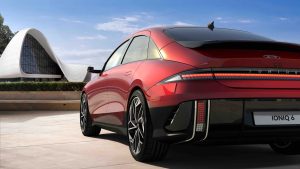
For just shy of half as much as Mercedes asks for the base-price EQE 350 with 260 miles of range and less power.
What’s New For 2024
The Ioniq 6 came out last year as a brand-new model so the changes for 2024 are minimal.
What’s Good
It looks like a Mercedes EQE.
It functions like a Mercedes EQE.
It costs half as much as a Mercedes EQE.
What’s Not So Good
Like other EVs, it doesn’t go as far as advertised if your driving isn’t mostly “city” driving.
As with other EVs, you have to think a lot about charging it.
Not much different than other EVs – as they’re all pretty much the same.
It’s more like what’s under the shell – when it comes to EVs. And all of them have more or less the same things under their shells. There’s a battery pack and – depending on the model – either one or two electric motors.
The base SE Standard Range trim comes with a 53 kWh battery a single electric motor driving the rear wheels. This combo offers a modest 149 horsepower and 240 miles of fully charged driving range. You can recharge it at home in about six hours, if you have upgraded your home’s electrical panel to accommodate a “Level II” (240 volt) outlet with its own dedicated 30 amp circuit. It can also be charged using an ordinary household outlet but this takes much longer. The third option is a high-voltage public “Level III” fast charger, which can get you back to about 80 percent charge after about 30 minutes.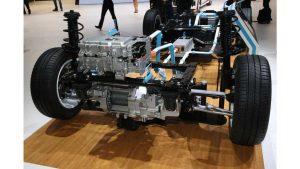
SE, SEL and Limited trims come standard with a more powerful 77.4 kWh battery and 225 horsepower for the rear-drive/single motor versions. You can opt for an additional motor (to drive the front wheels) and this boosts the Ioniq’s available output to 320 horsepower.
This, interestingly, is significantly more power than you’d get in a dual-motor Mercedes EQE 350, which only offers 288 horsepower and only goes 260 miles when fully charged.
Mercedes does offer a more powerful battery/motor combo that generates 402 horsepower in the EQE 500 – but it doesn’t go as far (298 miles, fully charged) and it costs more than twice as much ($85,900).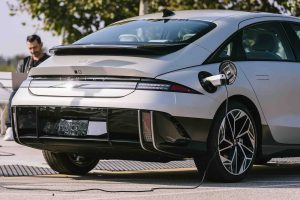
Another point of comparison is the Tesla Model 3, which is a smaller (compact-sized) car as well as a more expensive car, with a base price of $38,990. It goes a little bit farther (272 miles) with its standard-range battery. But whether the 32 mile difference constitutes a meaningful difference is something you’ll have to decide.
A more relevant difference, arguably, is the price difference between a Tesla 3 with optional “long range” battery – which stickers for $45,990 and goes 341 miles on a full charge – vs. the Ioniq SE with its longer range (361 mile) battery that costs about $3,500 less. That latter is not just money in the pocket. It’s also money you can spend to have your home’s electric panel upgraded to accommodate a “Level II” charging circuit and pay for probably a year’s worth of electricity, too.
The Ioniq 6 drives just like a Mercedes EQE and both drive a lot like a Tesla. This ought to be no more surprising than the not-much-different operating characteristics of a DeWalt vs. a Makita battery-powered drill. It’s hard to impart much difference in things that are so fundamentally similar.
You push the on button (EVs do not start) and push down on what is no longer the gas pedal. The vehicle accelerates smoothly and silently. Like other EVs, the Ioniq 6 responds immediately and forcefully to downward pressure on the accelerator; this is a function of the immediately available torque produced by electric motors that is applied directly to the driven wheels, there being no transmission in between. Also no shifting as you accelerate. The speed just builds until you ease off the accelerator.
You can dial up more acceleration by depressing the conveniently mounted (on the lower left of the steering wheel) button that allows you to select from Normal, ECO and Sport settings. The button is right where it needs to be to allow for quick toggling from one mode to the other – as for example from Normal to Sport when you need to call up maximum power to make a quick pass. Another well-situated (and well-designed) control input is the windshield wiper stalk-like range selector. Not how far you can go but how you engage Drive and Reverse. Roll it toward you for Reverse and forward to get Drive. For Park, just push the button on top of the stalk.
It’s all very easy-to-use and makes driving this electric Hyundai a non-frustrating experience and much more straightforward than dealing with a Tesla’s center-mounted LCD touchscreen.
But you will probably experience what I did if you drive the Ioniq 6 faster than 60 MPH consistently, especially if the AC’s running.
Just like every other EVs I have test driven – which is most of them – you’re apt to experience a roughly 20 percent difference between the indicated range remaining and how far you can actually drive before you run out of charge. Use of the AC on a hot day triggered an immediate adjustment of the indicated range remaining by about 8 miles. It doesn’t sound like a lot, but when you consider that haven’t got much to begin with, it’s a significant loss.
On the other hand, it is possible to exceed the indicated range remaining in low-speed, stop-and-go “city” driving, which is the kind of driving most favorable to an EV because you’re not moving as much – and moving more slowly. If EV manufactures could focus on maximizing efficiency in “city” driving – and forget about trying to also manufacture EVs that can sustain highway speeds for hours – it would be easy to manufacture a “city” EV that cost half or less what the Ioniq 6 costs that would be practical as well as affordable for people who do most of their driving in the city.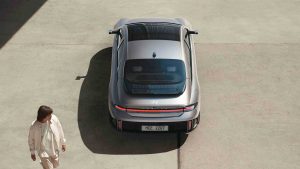
At The Curb
The most striking thing about the Ioniq 6 is how closely it resembles the twice-as-much Mercedes EQE. If the two were parked curbside and you viewed them from the side, you’d be hard pressed to say which was which from 20 yards out. Part of this is due to the necessity of making EVs as aerodynamically slippery as possible, in order to help extend their range (especially at highway speeds) as much as possible. But the similarities here are so close it’s difficult to imagine there wasn’t also some emulation involved.
And – if so – that was really smart of Hyundai.
Just as it was smart of Toyota – back in the late 1980s – when it styled its Toyotas to look like Mercedes. These were marketed under the Lexus brand – and that really dug into Mercedes’ sales.
This may do the same – and (again) not just because the Ioniq does a fine visual impression of a Mercedes EQE but because it may as well be a Mercedes, for all the difference there is. The latter has a huge plastic three-pointed “Mercedes” star affixed to its front end. That and the price constitute the major meaningful differences.
Wait. There is one meaningful difference.
One that’s very much in the Ioniq’s favor. It is that it’s a hatchback sedan. The EQE looks much the same but isn’t. It has a 15 cubic foot trunk. The Hyundai has about the same advertised space but it’s much more usable space because of the hatchback layout, which provides access to the entire interior of the car. Interestingly, the even-more-expensive Mercedes EQS – which looks like a larger EQE – is a hatchback. But if you want a “Mercedes” hatchback’d EV, the starting price is $104,400.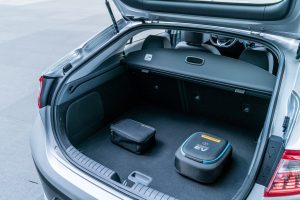
For that, you could buy three Ioniqs. Keep one (or two) hooked up to the charger while you drive one of the other ones.
Of course, you won’t get the plastic three pointed star – if that matters to you.
The Rest
One of the features this EV has that many others don’t is a more efficient heating system – for the cabin. Rather than a system that’s similar to the electric baseboard heaters found in many homes that burn a lot of electricity to warm the place up, the Ioniq has a heat pump system that doesn’t burn through as much charge (and so, range) which means you don’t have to choose between getting there and staying warm on the way there.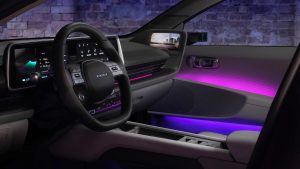
However, using the heater will nonetheless reduce your range because using the heater in a battery powered vehicle still burns power. Just a bit less in this case.
A feature this EV doesn’t have that it probably ought to is a “fuel” door that’s mounted up front – so you don’t have to back-up to be close enough for the cord to reach the plug.
Be aware that if you choose the SEL or Limited trims, you’ll get taller 20 inch wheels – and a bit less range (305 miles for the rear drive version, 270 for those with AWD) due to the increased weight and rolling resistance.
The Bottom Line
It not only looks a lot like a Mercedes – it is a lot like a Mercedes. And in many ways, it’s better than the Mercedes it looks like.
For a lot less money.
. . .
If you like what you’ve found here please consider supporting EPautos.
We depend on you to keep the wheels turning!
Our donate button is here.
If you prefer not to use PayPal, our mailing address is:
EPautos
721 Hummingbird Lane SE
Copper Hill, VA 24079
PS: Get an EPautos magnet or sticker or coaster in return for a $20 or more one-time donation or a $10 or more monthly recurring donation. (Please be sure to tell us you want a magnet or sticker or coaster – and also, provide an address, so we know where to mail the thing!)
If you like items like the Baaaaaa! baseball cap pictured below, you can find that and more at the EPautos store!






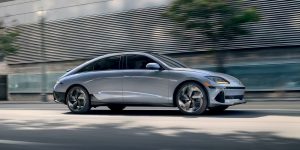







So did you drive it 4 hours straight to run down the battery? Why don’t you like the constant acceleration? Do you have a problem with not having a transmission? You and your friends LIKE buying gas, and changing oil? Why did you even bother to review this car? Why didn’t you tell them you don’t want to touch this horrible EV? I wanted to know about this car, and all you did was compare it to another car. You’re the kind of guy with the horse that laughed whenever a model T got stuck.
Hello, Choking –
First, your handle is absurd. No one “chokes” on the “fumes” of any car made since about 40 years ago – as no cars made since then that are in proper working order produce any “fumes” you can even smell. As opposed to the caustic fumes generated by a lithium-ion battery fire.
No, I did not run it four hours straight. But you make my point for me. I can run my truck four hours straight without any hassle. I can run it eight hours straight, with just a five minute stop to fill it up.
Yes, I like buying gas – because it’s easy and convenient. Charging EV batteries is neither. Oil changes? Once a year – takes 15 minutes and about $50 to do myself. How much does it cost to replace an EV battery? Can you do it yourself? How about the 30 percent decrease in tire life caused by the weight of EVs? Do you like having to buy new tires more often?
A horse and Model T?
The Model T was superior to the horse! That is why the Model T replaced the horse! It also replaced the early EVs. Did you know that?
And why not compare this EV to the same thing that isn’t? Is the comparison – of cost/range – not valid?
And they ask me why I drink.
Don’t buy an EV…..they cost far more to repair then an ice car….if you can find anyone that can even fix it….which is near impossible….
An EV will bankrupt you…lol….that is the purpose…stop slaves driving around…
Almost $10,000 to replace a burnt out charger connector…
About $14,000 to repair the heater….
https://www.youtube.com/watch?v=Q_wykTMknmI
Gauges? What gauges? We don’t need no st-eeee-nkin’ gauges.
Chip me up, Jesus.
Have Cash Cab lighting-like interiors and special digitized lasers for the 3-D effect, really cool lighting in the interior would be a definite sell, great gimmick.
Have your cellphone and ask Julia Googlia where you are, how fast you are going, the battery charge level, the whole enchilada. She’ll be able to drive your car too!
Don’t need a large screen on the dash, drive by voice, Julia will take you there.
Your cellphone is going to be the first choice, not a screen that can go dead at any time all of a sudden. Another cellphone is easily purchased in an hour.
Some people are all of a sudden dying, it’s kind of normal in bizarro world.
It can happen to you, nothing is immune to sudden death.
I purchased a new laptop, in less than three years, it was dead just like that, no screen, no charge, nuzzing. Have to replace what you had if you want to keep going.
The future of batteries in battery-powered electric appliances, has to be. In one word: dead.
Quit doing something and just sit there.
So why didn’t Hyundai slap a Genesis badge on this?
Maybe it just didn’t have that invisible touch.
I’ve got no reply at all to that.
I would buy some Mercedes Benz emblems and slap those on the Ioniq 6. There would be the problem of course of integration.
I bought some black emblems for my ’23 Traverse and put those on. This took me about a half hour or so. The front emblems were a slight hassle as there was not a lot of room for maneuvering. I used an extra long flat head screwdriver and pushed the clips aside after moving the shroud an inch or two.
On the rear of the Traverse I put on a “3.6” emblem. This emblem came from the Cadillac parts bin. I used the 3.6 emblem because the engine is the same as used on the Buick and Cadillac and Camaro. The Camaro of course has 335 HP and the other 3.6 engines have 310 HP. Maybe the Camaro has a different engine tune and exhaust system.
There are many de-badgers out there.
Now I just have to find an exhaust system that gives me the sound of a Corvette or Hi-performance Camaro.
Hi Euro,
I wish I had a spare “Benz” badge lying around to stick on the Ioniq while I was driving it! The whole thing is as infantile as ’80s-era rappers wearing the three pointed star as jewelry.
Gnomesayin’?
No transmission hump because no transmission or driveshaft, but now they’ve got these huge consoles in that spot, taking up a third of the width of the car (and restricting one’s ability to move and be comfortable). And they’re getting bigger and bigger. You don’t get in to one of these “cars”; you put them on.
What’s apparent to me with respect to the Hyundai Ioniq vis-a-vis the Mercedes Benz EQE is that the Hyundai proves once and for all that “luxury” car brands are Not Worth It.
There was a time, in fact, when I was first driving, that a luxury brand meant something tangible and meaningful, and while you did pay more—A LOT more—you got more.
You got more style. You got better build quality. You got more attention to detail. You got a better ride. You got more creature comforts. You got performance. You even got more safety.
None of that is true today. Plebeian Toyotas, Hondas, Subarus, Hyundais, KIAs, etc. have all those things—and rate better in reliability at a lower cost than Mercedes, BMW, Jaguar, Audi, and Porsche. What you’re paying for is the hood ornament.
And with vehicles becoming devices, the coffin has been nailed shut.
I would buy an older luxury car, like an old Cadillac DeVille/Fleetwood Brougham/Eldorado, Lincoln Continental/Mark Series, or Chrysler Imperial. I would not buy any luxury car made now.
Amen, Bryce –
I can attest to this from extensive experience. The current crop of MB vehicles are nothing special. Same plastic everywhere. Same gimmicks, such as “ambient” lighting and projecting an image of the badge on the ground when you open the door. Same basic flatscreen dashboards. They feel- and are – cheap. Yet they are very expensive.
It’s a sad gyp.
20 years ago, when I got a Benz S-Class to drive, it was something more. A V8 at the least – and a V12 available. They were objectively more for the money. Now it’s just more money.
BMW similar “gyp” – this “luxury” brand up-charges for metallic paint,
leather, wireless phone charging. remote start, etc.
Make mine Toyota, Mazda, Hyundai, et al.
It’s not even just the powertrain in the MB’s that made them so desirable, it was the feel, like a bank vault on 4 wheels, the interior trim finely crafted and the instrument panel that looked like a Rolex.
Mercedes-Benz will probably devolve into a “premium” badge slapped on no-name Chinese crap eventually. Don’t forget, its biggest single shareholder is the Chinese BAIC Group, with investor Li Shifu (known as the owner of Chinese automaker Geely, whose brands Volvo and Polestar may ring a bell) also being a significant shareholder, so Mercedes-Benz is well on its way to becoming Chinese already. Perhaps that’s why its cars are starting to feel cheap (the price tag notwithstanding).
The most valuable consumer brand in the world, Apple, makes generic products with different “skins” according to function. Their A and M series chips share nearly identical core processing engines (based on ARM designs, just like the majority of Android phones), the main difference being memory architecture and graphics coprocessors. They’re cheap and scale easily.
When you get a new phone, the first thing you do is transfer all your old stuff over to the new one. It powers up after the transfer and looks exactly like it did before, just “better.” All your apps, all your login settings, mom’s phone number, all there just where you left them.
If the powers that be really want EVs to make it, they should be offering lots of customization. Maybe not the exterior shape (although it should be easy enough to do that too), since you really can’t tell the difference between phones just by looking except for one-off cases like folding screens, but interior layout, dash features, all that stuff should be customizable by an outfitter or dealer. Or better yet, DIY with rails and other attachment points. Then when you get a new EV because it has “better,” the dealer can grab your stuff and outfit it again. And maybe upsell you on a new layout if your needs change.
Of course that would require a racial change in regulation. The car is a complete product as tested by the NHTSA, and once it’s earned its 5 star rating (which they all magically do somehow), nothing can be changed. And because testing costs money, no interesting new ideas can be tested -better just go with what worked before, that’s the safe route.
If the powers that be really want EVs to make it, they should be offering lots of customization.
If they really wanted EVs to make it, they should have made 300 mile of realistic range on a single charge and a 0-100 % charge in max 5 minutes standard and mandatory.
Of course, they don’t really want EVs to make it, they just want people out of their cars…
Well duh. But comparing the old Nokia “candy bar” phones’ days of battery life vs even modern smartphones’ daily charging ritual to EVs and ICE cars, why not play to the strengths of each? Make people want an EV over a ICE. Right now there’s no benefit aside from virtue signaling. Because the cars are looking more and more alike due to the physics, why not design to make them interesting for reasons that aren’t possible with a gas engined car? Bob Lutz’ EV dream was a “skateboard” with all the drivetrain and battery storage, with any sort of body to be bolted on top. Why not do that?
I say, if manufacturers can’t even get the fundamentals right with EVs, then they should just pull the plug on them. They were a bad idea a century ago, and they are still a bad idea today. (Tesla does seem to be a leader in trying to distract from the fundamental flaws of its EVs by adding a plethora of gimmicks to them, but it doesn’t really help. Lipstick on a pig and all that…)
As for the analogy between the old feature phones vs modern day smartphones on the one hand, and ICE vs EV on the other, it’s not really a good one (even though EVs are sometimes referred to as iPhones on wheels). After all, the primary purpose of old feature phones was to make phone calls (and send text messages), whereas today’s smart phones are essentially pocket-sized computers (and therefore have higher power consumption than old phones), where calling and texting are just two features among many, and provided via apps. Moreover, either type of phone can be used while they are being charged. By contrast, the primary purpose of an EV is still just to transport people and goods from one point to another, just like ICE-powered vehicles, and the EV is unusable for this purpose during its regular intervals of ridiculously long downtime.
There’s the rub. EVs in their current form aren’t offering any advantage over an ICE drivetrain. E bikes are gaining some traction because they’re cheap and can get people who want to ride bicycles over the “hill problem.” They’re not better than motorcycles for transportation, but they are better than bicycles (for some. I’ll keep my granny ring for the hills for a little longer).
More interesting designs, or a far less expensive cost of ownership might be a catalyst to get their products into a niche. But they’re not fundamentally better at anything in their current form, and likely won’t ever be better either. Electric vehicles might make sense on a factory floor or warehouse, but that’s not going to pay back the investors.
‘Their A and M series chips share nearly identical core processing engines (based on ARM designs, just like the majority of Android phones)’ — ReadyKilowatt
Another corporate mendicant slops at the public trough, courtesy of the CHIPS ‘n Sciency Act:
‘Micron Technology has reached preliminary agreement with the Commerce Department to receive $6.1 billion to build a memory chip plant in upstate New York and to expand existing facilities in Boise, Idaho.
“The largest private [sic, ha ha, LOL] investment in American history is on its way to central New York,” New York Gov. Kathy ‘Ho’ chul said in a statement. “We’re going to revitalize our upstate eclownomy—one microchip at a time.”
https://tinyurl.com/jk6jvt2r
The fedgov’s slush fund shitshow has veered totally out of control. Might as well just sling a big stack of hundred-dollah bills into the fan blades and watch ’em blow.
Either the Mercedes or the Hyundai? Doesn’t matter – from the B-pillars back, they’re both hideously ugly. I choose neither.
“hideously ugly.”
All cars are designed for the Chinese market now…the biggest market….
It is all crap now….buy an old car….
Dumb question –can a car’s appearance be patented. If the Ionic truly is a knockoff of an EQE it would seem Mercedes has grounds for a lawsuit. Hell, all cars look alike anyhow…
Hyundai would just bring out the wind tunnel testing data that would show that the shape has been optimized for aerodynamic drag. Just like no one really owns the 2.0L 4 banger engine, there’s engineering data that shows the size and shape of the cylinder is optimal for fuel efficiency and performance.
Mike,
‘Design patents play a significant role in the automotive industry by protecting the unique and innovative aesthetic features of vehicles and their components. These patents grant exclusive rights to the ornamental design of a functional item, such as a vehicle front fender, headlight, or taillight. By obtaining design patents, automotive manufacturers can prevent competitors from copying their distinctive designs and maintain a competitive edge in the market.’
https://tinyurl.com/5bz668nv
Thinking to design patent my lantern-jawed, manly profile. 🙂
The third option is a high-voltage public “Level III” fast charger, which can get you back to about 80 percent charge after about 30 minutes.
I assume that you mean a “Level III” “fast“ charger?
Eric, your comment on using A/C while cruising over 60 explains much. That “much” is why whenever I see a Tesla, or other EV, on the interstate they are usually dawdling along, thankfully, mostly in the right lane.
EV’s for urban use makes sense. There the only problem in how to charge but, with an urban design you could use lead/acid batteries and eliminate the inherent problems with Lithium batteries.
Bottom line though is that if it really where about “saving the planet” and not control, you’d see a realistic push for urban use since that’s where the pollution problems are most evident. Maybe Greta needs to spend a few months working in the fields to get her mind right.
The dawdling has –much– more to do with the passive globohomo soft lefty rule following urban / suburban bugman behind the wheel than anything in the car itself for the most part.
Which is another baffling thing with EVs as their -primary- positive distinguishing feature which is absurd acceleration / torque is of 0 interest to probably 95% of the owners. 🤷♂️🤷♂️
If I’m not mistaken, LFP (Lithium Iron Phosphate) batteries offer the same safety that Lead/Acid batteries do, while offering superior energy density and lighter weight.
They’re somewhere in-between LiPO and lead acid, leaning toward LiPO. They don’t have the energy density of LiPO but are better able to tolerate abuse. Most of the RVers I know have swapped out their old AGM and lead batteries for LiFePO and love them. No maintenance, and double the capacity for the same space (and half the weight). I have a few on my equipment rack power supply from medical crash cart pulls, a much better option. They’ll keep my equipment powered for 6-8 hours no problem (actually stopped testing after 5 but going by the discharge curve). The old AGM batteries would drop below recommend discharge after around 2 hours and probably get permanently damaged after 3.
What Eric’s video, and the third-from-last photo, show are DUAL wide aspect ratio Clownscreens.
That’s the most aesthetically offensive dashboard EVER — both the massive screens, and their third-grade, Etch-a-Sketch level of graphic design banality and incompetence. With a bit of polishing, they might be upgraded to resemble a brightly-colored, circa-1995 GeoCities website template. But why bother?
I barf in disgust at this Korean knock-off of a plastic-starred Mercedes device. I’d rather buy a fake Rolex in China.
Unlike the battery-propelled, wheeled-cellphone devices offered by the German and Korean schlockmeisters, an actual Rolex offers infinite range and NEVER needs recharging:
‘In 1931, Rolex unveiled a self-winding mechanism with a free rotor designed for use in a wristwatch. Known as the Perpetual rotor, this patented system comprises a half-moon-shaped oscillating weight, which rotates in both directions whenever the wearer moves their wrist, winding the mainspring. This component stores and constantly releases the energy it receives, which enhances the precision of the regulating organ.’
https://www.rolex.com/watches/oyster-perpetual/features
Don’t want your Ioniq anymore
Don’t want your dual Clownscreens, that’s for sure
I die each time I hear this sound
Here he comes, that’s Hyundai’s clown
— The Everly Brothers, Cathy’s Clown